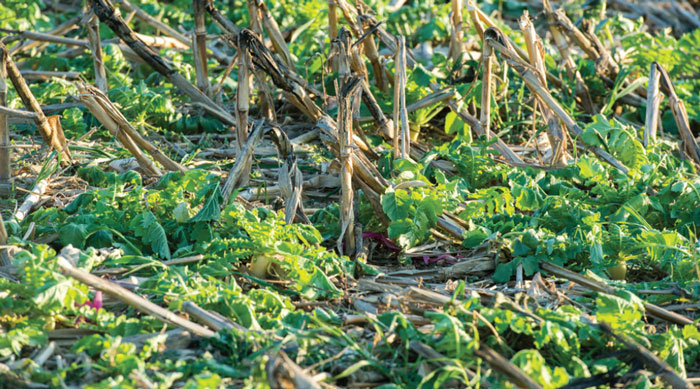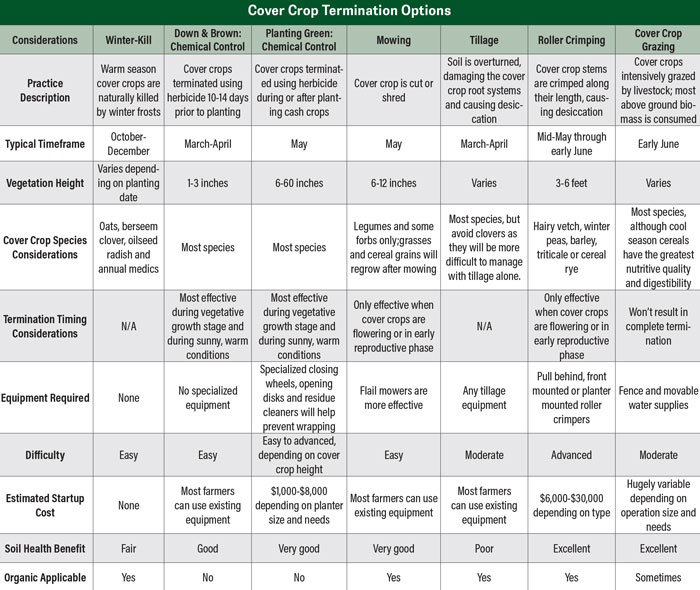Updated January 22, 2024
Cover crops need to be terminated (killed) before or shortly after the cash crops are planted. If termination is incomplete, the cover crops act as weeds, robbing the cash crops of moisture, sunlight and important nutrients.
There are a wide variety of cover crop termination methods suited for a wide range of operations, experience levels and goals. The following information outlines the most common termination practices, associated advantages and disadvantages and tips to increase success.
Natural Termination. Several cover crop species cannot survive colder winters. These cover crops will die over the winter (winter-kill) without the need for mechanical or chemical intervention.
Mechanical Termination. Uprooting cover crops using tillage or mechanically cutting the aboveground vegetation can be an effective method of termination. These methods, such as mowing, tillage and roller crimping, rely on cover crop species selection and termination timing to be effective.
Chemical Termination. The most common tool to control cover crops is herbicides, such as 2,4-D, glyphosate and Gramaxone. This can either occur before planting or, with certain herbicide-resistant cash crops, during or after planting.
Termination is a Balancing Act
Each spring, growers must decide when to terminate their cover crop. This is a balancing act between maximizing biomass production to enhance soil quality benefits and minimizing potential risk to cash crop planting and emergence.
When determining an ideal cover crop termination date, farmers need to consider the growing season of the cover crop, soil moisture, soil temperature, nitrogen management, allelopathy/weed suppression and equipment under a variety of different climate patterns and crop rotations.
“It is critical to wait 10-14 days after termination before planting the cash crop…”
Poor termination can result in cover crops becoming weeds and impeding cash crop germination, and in turn, significantly reducing yields and profit. All termination decisions impact profitability and the potential for economic gains or losses.
Early Termination. The choice to terminate early, for most farmers, is a practical one. In a cover crop only a few inches tall, termination and subsequent planting is relatively straightforward and requires little specialized equipment and supplies. Moreover, early termination paves the way for early cash crop planting. Terminating cover crops early is agronomically easier and poses less risk to cash crops.
Delayed Termination. Delayed termination is a practice with both significant potential risks and large potential rewards. Termination needs to be timed to maximize soil health gains without compromising crop yields. When executed correctly, innovative termination strategies accelerate soil organic matter formation, reduce weed and pest pressure, reduce the need for chemical inputs and increase water conservation. Delaying termination allows for a more significant potential for soil health gains.
Chemical Control Before Planting. Herbicide usage is the most common tool to terminate cover crops. It is fast, generally very effective and uses equipment that most growers already own.
Most cover crops are fairly easy to control in a burndown program as long as the farmer pays attention to detail. Keep in mind the following factors:
- Multi-species mixes can be challenging to terminate and generally require a multi-faceted herbicide program as each species will respond best to a different herbicide and will be at a different phase of development.
- Cover crop varieties will differ in their susceptibility to herbicide; talk to the seed dealer about how each responds to herbicide.
- More seed is not always better. Dense seeding rates necessitate higher herbicide application rates, particularly when relying on contact herbicides.
- Red clover and vetch are notoriously difficult to terminate.
- Winter wheat is more difficult to kill than cereal rye.
- Follow special recommendations to kill annual ryegrass.
Termination Timing. Target termination for when the plants are in a vegetative stage and the weather conditions are fair and conducive to growing. During these conditions, herbicides are more effective. Target termination for grasses before they joint and for legumes before stems elongate and become woody.
Planting After Terminating
Thick cover crop residues can be a nightmare to plant into. The long stems will bind and wrap around residue cleaners and closing wheels. The residues can create a slimy mat, particularly after rain events. Consider the following to reduce potential problems. Don’t let cover crops get too large, particularly when starting out. Cover crops under 6 inches tall shouldn’t wrap around equipment. Plant when dead cover crops are dry. Dry cover crop residue is easier to cut through, reducing potential problems with hairpinning.
It is critical to wait 10-14 days after termination before planting the cash crop. Newly killed cover crop leaves will be difficult to cut, increasing hair-pinning. Planting through cover crops that are brown and crispy will be easiest.
Chemical Control After Planting
Cover crops can be terminated during or after cash crop planting using herbicide. Glyphosate and other herbicides can be safely applied to GMO crops before or shortly after emergence.
Select cover crops that are relatively simple to kill using herbicides and that are slower to mature and enter the reproductive phase. Cover crops in reproductive phases are more difficult to terminate with herbicides.
Although there are many forms of “planting green,” (planting cash crops into a living cover crop), the most typical method is to terminate the cover crop in a vegetative growth stage (3-8 inches) at the same time as planting a genetically modified cash crop that will not be impacted by the herbicide. It is not uncommon for experienced growers to describe challenging experiences planting green. Tall covers can quickly bind around the many rotating elements of a planter or drill. Inadequate termination may leave cash crops struggling to compete against cover crops.
Most farmers aim to terminate cover crops within 7 days of planting cash crops and before emergence. The termination scenario adheres to NRCS, RMA and FSA recommendations and ensures the crop is eligible for crop insurance. Do not plant green when the long-term weather predictions call for a dry planting season.
Roller Crimping
Roller crimpers are round drums, typically with angled fins in a chevron pattern, designed to knock over tall cover crops, kinking the stems and damaging the plant's vascular system.
Not all cover crop species are suited to termination using a roller crimper. Elbon cereal rye, the earliest flowering commercial rye cultivar, is the most common cover crop choice for growers interested in using a roller crimper to terminate.

Choosing a water-filled drum (left) or planter mounted roller crimper (right) depends on the equipment a farmer has. Photo by: Underground Ag
Triticale may also be used; however, it won’t reach maturity until 5-7 days later than Elbon rye, further delaying cash crop planting.
Hairy vetch is the only legume suited to termination using a roller crimper. Conveniently, it also reaches reproductive maturity around the same time as cereal rye.
There are two common types of roller crimpers available. Planter mounted crimpers can be added to the front of planters, enabling crimping and planting in a single pass, while pull/push drum roller crimpers, the original roller crimpers with water-filled drums, are either pushed in front of or pulled behind a tractor.
Expert Tip
Over-Mature Cover Crops. "When a cover crop reaches reproductive stage (the boot stage in grass and bud stage in legumes), consider switching to a contact herbicide to burn the vegetation down. When regrowth occurs, the plant will be easier to control with a systemic or contact herbicide. If you terminate a cover crop after is has gotten too big, the dead cover crop can turn into a thick mat that will keep the ground from drying out. Terminate early, or be prepared to plant green."
—RJ Fulper, Fulper Family Farms, Labertville, N.J.
Timing is crucial for successful termination with a roller crimper. Grass cover crops should be roller-crimped after they start flowering (anthesis). Legumes, such as hairy vetch, should be roller-crimped after they start to produce pods. If using an independent drum roller crimper, it is critical to plant in the same direction that the crops were crimped.
Grazing Cover Crops
Most cover crops can double as a high-quality forage for livestock during early spring or late fall. Integrating livestock into crop systems accelerates soil health improvements.
Plant warm-season cereal grains, such as sorghum sudan and pearl millet, after harvesting winter grains.
If planting is delayed until after mid-August, plant oats and peas. The yield will be lower for the oats, but because warm-season grains tend to be lower in digestibility, the forage quality of the oats will be higher than that of the sorghum sudan or millet. After a frost, cool-season cereals like oats and barley wilt and discolor, but the forage retains its quality.

Winter-killed cover crops are the most common option for organic operations and a great low-risk option for beginning cover croppers. Photo by: USDA SARE
Cool-season cereals like winter wheat, oats, barley and triticale are popular for spring grazing. Cereal rye is the best choice for a grass that comes on early in the spring, although the forage quality of cereal rye will decline rapidly as it matures.
As a general rule, cover crops slated for grazing should be seeded at a 1.5-2 times higher rate than normal.
Dairy cows should consume fiber from cover crops that is more digestible in order to ensure high milk production. Beef production is different.
Typically, with dairy cows, graze the cover crops at an earlier stage of growth when the cover crop has more digestible fiber, compared to later grazing with higher levels of fiber that can be done with beef producing cattle. Dry cows and heifers can graze the more mature cover crops.
Expert Tip: Fall Grazing Brassicas. Dave Wilson, an agronomist at Penn State University Extension says that forage brassicas such as turnips, radishes, forage rapes and hybrid forage brassicas can be planted along with summer annual grasses like forage sorghum, sorghum-sudangrass, sudangrass and millet.
“Put the grass seed in the large box and the brassicas in the small box of the drill, but keep the seeding rate of the brassicas low at 2-5 pounds per acre,” Wilson says. “The brassicas are one of the few crops that will compete with the fast-growing summer annual grasses. They will grow underneath the canopy of the summer annual grasses, and you will have two levels of grazing, the summer annual grasses higher with the brassicas underneath. The brassicas will provide a higher portion of protein in the grazing mix.”
Wilson also says that if cattle have not grazed brassicas in the past, they may take a few days to get used to them. After that, they will consume them readily.
Cautions for Grazing Cover Crops
Many post-emergence herbicides used in corn — particularly in soybean production — prohibit using cover crops established in these fields for feed.
Allowing animals to graze wet fields can negate potential soil health gains. Wet soil compacts easily; cattle trampling can easily ruin a no-till field. Heavy corn residues will protect the field to some extent, but always remove cattle from saturated soil.
Nitrates concentrate in cover crops during cool, cloudy conditions to create toxic nitrate levels, particularly in the stem or stalk. Prussic acids can be a concern in warm season annuals after frosts and when plants are young or there is new regrowth following grazing or frost.
When grazing cover crops, farmers aim to provide nutritious forage and severely stunt vegetative growth through intentional over-grazing. This is best accomplished through mob grazing or other forms of intensive rotational grazing wherein livestock are confined within small temporary paddocks at high stocking rates for a short amount of time.
“brassicas will compete with summer annual grass…”
Animals can be confined using temporary or permanent fence. Most permanent fences consist of 3-5 strands of electrified wire, while temporary fence is a more cost effective option for livestock well trained to a hot wire and areas where animals are not likely to cause a threat to human safety if they escape.
Growers who don’t have the option of installing fences for grazing can harvest the cover crops as a second spring crop. Cover crops will create high-quality forage with large income potential. However, the harvest and removal of the above ground biomass reduces potential soil health gains.
Grazing will not fully terminate cover crops. Grazing severely reduces the above ground biomass and stunts the crop’s growth. However, farmers need to employ a secondary termination strategy to achieve full termination. Most farmers will use a light application of herbicide or tillage to terminate the remaining cover crop.
Winter-Killed Cover Crops
Winter frosts will naturally kill certain annual cover crop species. The mat of cover crop residues offers protection from erosion during the winter. Winter-killed cover crops differ in their tolerance to frost. Some species, like sorghum sudangrass, buckwheat, field pea and oilseed radish, are highly frost sensitive and will die after the first hard frosts.
Other species, like oats and some brassicas sown in the summer, are somewhat less sensitive to frost and will put on a lot of growth and often maintain active growth into early November, dying slowly after several hard frosts.
To maximize biomass production, winter-killed crops should be seeded in mid-to-late-summer. Oats may be seeded as late as mid-September in milder climates.
Most winter-killed cover crops will have begun to decompose by planting time in the spring. The nitrogen-rich residues may even accelerate the decomposition of other brown residues from the previous season. Decomposing residues on the soil surface may delay soil drying and warming in the spring.
“Do not attempt to mow prior to using herbicides…”
Some pros to winter-killed cover crops include zero termination related expenses and the ability to plant cash crops early in growing season. On the other hand, cover crops need to be established earlier to achieve adequate growth before winter-killing. Lack of living roots in the soil during winter and spring months leaves soil vulnerable to leaching and erosion. Winter-killed cover crops are the most common option for organic operations and are a great low-risk option for beginning cover croppers.
Mowing
Timely mowing can be an effective tool to terminate some cover crops without disturbing the soil or using herbicides. Mowing is only effective for killing certain cover crop varieties at certain times in their growth cycle. Barley, cereal rye and hairy vetch can be effectively killed through timely mowing.
Many forbs and brassicas can also be effectively terminated through mowing. However, as they also tend to winter-kill, such interventions are typically not necessary. It is also important to keep in mind that multi-species mixes will flower at different times. Because of this, growers will not be able to mow at full bloom, and termination will be less effective.
Mowing is only effective as a termination tool during early reproductive phases (flowering). During this phase in plant development, plant energy is concentrated into producing seeds, and the plant will generally die when mowed.
Rotary mowers can lead to windrowing of cover crops, making some strips hard to plant with the uneven residue. A flail mower is more ideal if the biomass gets too high. Another less common option is the undercutter roller, which is designed to slice shallowly through the soil and cut cover crop roots underground. Do not attempt to mow prior to using herbicides. If you mow and then decide to use an herbicide, the effectiveness of most herbicides will decline.
Planting with a planter or drill may be very difficult after mowing. The plant stems detached from the roots will tend to bind or wrap around the equipment. The mowed stems will face in many different directions. As a result, the use of mowing to terminate cover crops should be reserved to situations where vegetable or specialty crops will be planted by hand, or the stems will be lightly incorporated into the soil.
Never seed cash crops using a drill or planter through mow-killed cover crops unless the crops were harvested and removed. The loose stalks will bind row cleaners and closing wheels.
The No-Till & Cover Crops Handbook was authored by Bridgett Hilshey, Christian Bench and the North Jersey RC&D, with content based upon work supported by the USDA, through the Northeast Sustainable Agriculture Research and Education (SARE) program.




